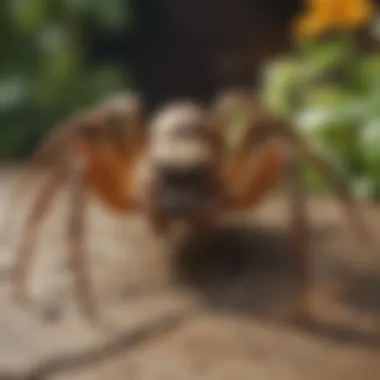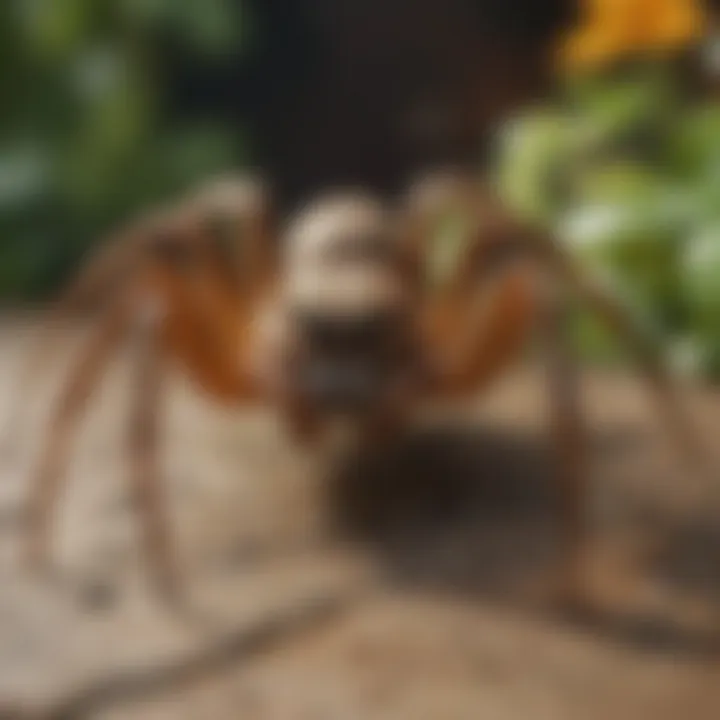Effective Strategies to Eliminate Spiders from Your Garden


Intro
Gardening can be a fulfilling and serene endeavor. However, it can also invite unwanted guests, such as spiders. Spiders play various roles in the garden, but unchecked populations can create concern among homeowners. Managing spiders effectively requires a blend of understanding, identification, and strategic action. This article explores ways to control spider populations in your garden environment thoroughly.
Pest Identification
Detailed Descriptions of Common Pests
To take control of spider populations, it is essential to identify the types of spiders typically found in gardens. Common garden spiders include:
- Garden Spider (Araneus diadematus): Recognizable by its large, web-like structures, this spider is usually yellow or brown, often with white markings.
- Jumping Spider (Salticidae family): Known for its quick movements, this spider has a stout build and is friendly compared to others. It does not create webs but instead hunts for prey.
- Wolf Spider (Lycosidae family): This spider is notable for its agility. It is larger than many garden spiders and does not spin webs but rather stalks its prey.
Signs and Symptoms of Infestations
Recognizing signs of spider infestations can help in taking timely actions. Look for:
- Visible webs: While some spiders don’t create webs, many do. Their presence can indicate a growing population.
- Increasing sightings: Regular sightings of spiders in your home or on your plants are strong indicators of infestations.
- Prey presence: If you notice an increase in insects that spiders commonly feed on, such as flies or moths, it may mean spiders will soon follow.
Prevention Strategies
Home Maintenance Tips for Pest Prevention
Prevention is often more effective than elimination. Consider the following strategies to deter spiders:
- Regularly clear debris: Keep your garden tidy by removing leaves, clippings, and any pile of debris where spiders can hide.
- Maintain plants: Trimming plants can prevent spiders from finding shelter. Regular pruning promotes air circulation and prevents dense growth that can harbor pests.
- Seal entry points: Inspect your home. Use caulk or weatherstripping to close gaps around windows and doors, reducing potential spider entry.
Natural Deterrents and Barriers
Utilizing natural methods can discourage spiders without harming other garden species. Here are a few:
- Essential oils: Some oils, like peppermint or tea tree oil, can repel spiders. Mix a few drops with water and spray in areas where spiders are seen, avoiding direct application on plants.
- Diatomaceous earth: This natural powder can be spread around your garden. It can dehydrate unwanted pests, making it difficult for spiders to find food.
- Garlic spray: Creating a garlic-based spray can also deter spiders. Blend garlic with water, strain it, then spray it in areas of infestation.
Treatment Options
Overview of Chemical vs. Natural Treatments
When facing significant spider populations, the choice between chemical and natural treatments arises. Chemical solutions, while effective, may disrupt the garden's ecological balance. In contrast, natural alternatives tend to be safer for plants and beneficial insects but may require more frequent application.
Step-by-Step Guides for DIY Treatments
For homeowners interested in performing their own pest control, here are some simple approaches:
- Peppermint Oil Spray
- Diatomaceous Earth Application
- Ingredients: 10 drops peppermint essential oil, 2 cups water, 1 teaspoon dish soap.
- Instructions: Mix ingredients in a spray bottle. Apply in areas where spiders frequent.
- Instructions: Lightly dust diatomaceous earth around plants and home perimeters in dry conditions.
"Understand your environment. Knowledge of spider species can lead to effective management without losing beneficial species like ladybugs or lacewings."
By implementing these strategies, homeowners can create an inviting environment for themselves while keeping unwanted spiders at bay. Manage your garden with precision, ensuring that it remains a peaceful retreat.
Understanding Garden Spiders
Understanding garden spiders is pivotal to managing their populations effectively. By knowing the various types of spiders, gardeners can make informed decisions about control methods while considering their ecological importance. This knowledge is vital for maintaining a balance between protecting your garden and preserving the natural environment.
Identifying Common Species
Identifying different species of spiders in your garden allows you to assess their roles in the ecosystem and determine if they pose a threat or can be beneficial.
Orb-Weaver Spiders
Orb-Weaver spiders are known for their intricate webs, which they create in gardens. These spiders have a distinct body shape, usually characterized by large, bulbous abdomens. They provide the benefit of capturing a variety of garden pests, including mosquitoes and flies. Their webs can be unsightly if left unattended, but they contribute significant pest control. The unique circular web patterns of Orb-Weavers show their expertise in dragging prey into their traps effectively. However, gardeners should remember they can build webs without discretion, leading to aesthetic concerns.
Tangleweb Spiders
Tangleweb spiders weave irregular, messy webs that can be found close to the ground. This species prefers undisturbed areas, making them common in overgrown gardens. They play a role in controlling pests by trapping them in their webs. Their distinctive tangles are not as aesthetically pleasing as other webs but serve important ecological purposes. Plus, they often catch insects that other spiders might miss, increasing their value in pest management. The disadvantage is that their web-building methods can lead to cluttered garden spaces.
Jumping Spiders
Jumping spiders are small and agile, well-known for their hunting abilities instead of web-building. They possess excellent eyesight and leap to capture prey, such as flies and moths. This adaptability makes them invaluable for controlling outdoor pest populations. Their hunting strategy minimizes the need for webs, which some gardeners find appealing. On the downside, their small size can make them easily overlooked, leading to an underappreciation of their contributions to pest control.
Black Widow Spiders
Black Widow spiders are infamously known for their potent venom and striking appearance. They are typically black with a red hourglass mark. While their presence can signal danger, they also provide a form of natural pest control. By preying on larger insects, they help keep pest populations in check. However, their venomous nature raises valid concerns for gardeners, emphasizing the need for caution. The potential health risks associated with their bites complicate their role in the garden ecosystem.
The Role of Spiders in the Ecosystem
Spiders, often viewed as nuisances, play crucial roles in maintaining the ecological balance in gardens. Understanding these roles helps conservatives flourish in an environment conducive to growth.
Natural Pest Control


A primary role of spiders is natural pest control. They effectively reduce the number of harmful garden pests, thus contributing to healthier plant growth. Spiders trap insects that harm plants and crops, maintaining necessary ecological balance. Their presence increases biodiversity, which is essential for a thriving ecosystem.
Spiders can significantly reduce the need for chemical pesticides, promoting safer gardening practices.
Food Source for Other Wildlife
Spiders also serve as a food source for various wildlife. Animals such as birds and lizards depend on spiders as part of their diet. This relationship underscores the interconnectedness of garden ecosystems, illustrating how each species contributes to the overall health of the environment. Although spiders might seem like a burden, they support a broader food chain that sustains other beneficial wildlife. Each species fulfills a specific role, making it imperative to consider their contributions when assessing garden populations.
Reasons to Control Spider Populations
Understanding the reasons to control spider populations is a significant aspect of maintaining a healthy garden environment. While spiders can play beneficial roles, such as pest control, their unchecked presence can lead to various issues that impact both health and aesthetics. Homeowners need to consider the balance between natural ecosystems and the potential hazards posed by certain spider species.
Health Risks associated with Spiders
Venomous Spiders
Venomous spiders present a clear risk to humans and pets. Notable examples include the Black Widow and Brown Recluse spiders. Their bites can lead to severe medical complications, including pain, swelling, and in rare cases, systemic reactions. In gardens, the presence of these spiders can limit outdoor activities, particularly for families with small children. They are often found in undisturbed areas, making regular control measures essential to minimize risk.
A key characteristic of venomous spiders is their ability to deliver toxins through their bites. This ability can be a significant concern for those who are unaware of the specific dangers in their gardens. Identifying these spiders promptly allows for targeted control efforts. Ensuring a thorough understanding of these species contributes to an informed approach in managing spider populations.
Allergic Reactions
Allergic reactions to spider bites can occur in sensitive individuals. While most spiders are harmless, the immune response to a bite may lead to symptoms like itching, hives, or more serious issues. This risk is especially pertinent in areas frequented by children or pets who might provoke spiders inadvertently. When considering spider control in gardens, addressing the potential for allergic reactions is crucial.
Notably, reactions can vary widely from person to person, which means even non-venomous bites might cause serious discomfort for some. Consequently, reducing spider populations can lower the risk of bites altogether, benefiting everyone involved. Hence, paying attention to spider control becomes important not just for health but also for peace of mind.
Impact on Garden Aesthetics
Web Formation
Web formation by spiders is a natural process, but it can detract from the visual appeal of a garden. Intricate webs may deter visitors and lead to an impression of neglect. Homeowners often invest significant time and resources into maintaining gardens to create inviting spaces. The presence of extensive spider webs can affect this perception negatively.
A significant aspect of spider web formation is its potential to catch debris and other organic material, creating an unkempt appearance. Addressing this issue through control measures can enhance the aesthetic value of a garden. Therefore, gardens can benefit from strategies that minimize spider webs while balancing the need for ecological health.
Visitor Perception
Visitor perception plays a vital role in how a garden is evaluated. Guests may feel uncomfortable or scared upon encountering spiders. This reaction can diminish the enjoyment of outdoor spaces, dissuading friends or family from visiting. Creating a welcoming environment means ensuring that visitors feel safe and at ease in a garden.
Highlighting the importance of managing spider populations can help homeowners cultivate a more pleasant experience for themselves and their guests. A garden free from the fear of spiders fosters appreciation for nature's beauty without the discomfort that can arise from its less desirable inhabitants.
Effective spider management balances ecological needs with human comfort, leading to a healthier garden environment.
In summary, addressing the reasons for controlling spider populations involves careful consideration of health risks and aesthetic impacts. Homeowners should recognize the complex interplay between ecosystem dynamics and their need for a safe and inviting outdoor environment.
Preventive Measures for Spider Control
Preventive measures are the first line of defense in controlling spider populations in your garden. By addressing conditions that are conducive to spider habitation, you can significantly reduce their presence. Preventive techniques are often more effective than reactive measures because they tackle the root causes. Implementing these strategies may lead to a healthier garden ecosystem and less invasive control methods later.
Regular Maintenance and Cleaning
Regular maintenance and cleaning not only enhance the aesthetic appeal of your garden but also help in spider control.
Clearing Debris
Clearing debris involves removing fallen leaves, wooden scraps, and any clutter that can provide shelter for spiders. This practice is crucial for maintaining a low spider population. Debris can attract not just spiders but also their prey, which consequently increases their presence. The key characteristic of clearing debris is that it undermines the preferred hiding spots for spiders. Therefore, it is regarded as a beneficial choice. This technique supports a cleaner garden environment by eliminating potential nesting areas and allows for easier visual inspections of spider activity. Its advantages include reducing spider density, while a disadvantage may be the initial time investment.
Trimming Vegetation
Trimming vegetation is another effective measure to control spiders. Overgrown plants can create a dense habitat where spiders thrive. Keeping your plants trimmed can minimize shaded areas that harbor pests and spiders. The key characteristic of trimming vegetation is that it promotes air circulation and sunlight penetration, making it less inviting for spiders. This method is popular because it simultaneously enhances the appearance of your garden. Unique features include the prevention of excess overgrowth that can encourage spider webs and nesting. Advantages include increased visibility and easier pest management, while a disadvantage may be the need for regular upkeep to maintain desired plant shapes.
Implementing Physical Barriers
Physical barriers serve as an effective method to prevent spiders from entering your garden spaces. These barriers deter spider movement and offer additional defense against other pests.
Installing Screens
Installing screens on windows and doors is an effective way to keep spiders out of indoor environments. By preventing spiders from easily entering your home, you reduce the likelihood of infestations. The key characteristic is that screens are a passive form of protection, requiring no chemical intervention. This is a beneficial choice in terms of safety and ease of use. Unique features include various sizes and materials available, catering to different garden and household designs. Advantages include reducing indoor spider sightings, while a disadvantage may be that screens require periodic maintenance to ensure effectiveness against small openings.
Utilizing Mulch
Utilizing mulch serves to create a robust barrier against moisture build-up, which is attractive to spiders. Organic mulch such as wood chips or straw can inhibit spider movement by making their preferred habitats less favorable. The key characteristic of mulch is its ability to suppress weed growth while improving soil moisture retention. This is a beneficial choice because it serves multiple purposes beyond just spider control. A unique feature is that different types of mulch can enhance soil fertility over time, aiding in overall garden health. Advantages include creating a less inviting environment for spiders and nourishing the soil. Disadvantages include the need for regular replacement to maintain its effectiveness.
Natural Deterrents for Spiders
Natural deterrents play a crucial role in managing spider populations effectively, particularly for homeowners seeking eco-friendly solutions. They offer a preferable alternative to chemical insecticides by reducing the reliance on synthetic compounds that may harm beneficial insects and the environment. By utilizing natural methods, you can discourage spiders from taking up residence in your garden without creating significant disturbances in the local ecosystem. Key benefits include safety for pets and children, as well as maintaining an organic gardening approach.
Essential Oils as Repellents
Essential oils have gained popularity as natural repellents due to their ability to emit strong scents that spiders find unpleasant. They provide a simple and effective way to deter spiders while also adding pleasant aromas to your surroundings.
Peppermint Oil
Peppermint oil is highlighted for its ability to repel a variety of pests, including spiders. Its strong, minty aroma is a key characteristic that makes it a favored choice. The oil works by masking the scents that attract spiders, creating an unfriendly environment for them. One unique feature of peppermint oil is its versatility; it can be used in various forms such as sprays or soaked cotton balls placed around your garden.
Advantages of peppermint oil include its availability, ease of use, and effectiveness. However, one disadvantage is that the scent may fade over time, requiring frequent reapplication to maintain its effectiveness.


Eucalyptus Oil
Eucalyptus oil is another effective natural deterrent. Its refreshing scent works similarly to that of peppermint oil, making it another viable choice in spider management. It is often appreciated for its antimicrobial properties, which can benefit your garden health as well. A unique feature of eucalyptus oil is its use in various conditions, from garden pests to respiratory relief in humans.
While the advantages of eucalyptus oil include its broader pest-repelling quality and health benefits, a potential disadvantage is the fact that some may find the strong scent overpowering, necessitating careful application to ensure comfort for all garden users.
Plant-Based Solutions
In addition to essential oils, specific plants can act as natural barriers to spiders in your garden. Planting these species not only beautifies your space but also serves functional purposes in managing pest populations.
Marigolds
Marigolds are particularly effective due to their strong scent and ability to repel various insects, including spiders. Their vibrant colors also enhance garden aesthetics. Marigolds are a beneficial choice because they thrive in different conditions and can easily be integrated into most garden designs. A unique feature of marigolds is their ability to attract beneficial insects that can further aid in pest control.
However, a drawback of marigolds is that they require regular maintenance, such as deadheading, to promote continued blooming and efficacy.
Lavender
Lavender is well-known for its soothing fragrance and is also an effective spider repellent. The aromatic properties of the flowers have made it a popular choice in gardens. Lavender's relaxing scent is highly regarded, providing both aesthetic and practical advantages. This plant not only deters spiders but also attracts pollinators, enhancing the ecological balance of your garden.
On the downside, lavender may not thrive in all soil types and requires specific growing conditions. This can pose challenges for some gardeners who may need to adjust their gardening strategies to support lavender health.
By combining various natural deterrents, homeowners can effectively manage spider populations while maintaining a healthy garden environment.
Chemical Control Options
Chemical control options are a significant consideration when managing spider populations in gardens. Although many may prefer natural methods, sometimes these approaches are insufficient. Chemical treatments can effectively reduce spider numbers, but they should be used judiciously. Understanding the specific products available can aid in making informed choices that respect both the ecosystem and the aesthetic quality of the garden.
Insecticides Overview
Chemical insecticides can be classified into various categories, but two of the most notable are Pyrethroid-based products and Neonicotinoids. Each of these has distinct attributes that impact their suitability for spider management.
Pyrethroid-Based Products
Pyrethroid-based products are synthetic versions of pyrethrins, which are derived from chrysanthemum flowers. They are particularly effective in exterminating a wide range of insect pests, including spiders. A key characteristic of pyrethroids is their quick action, which makes them a popular choice among gardeners looking to address immediate spider issues.
The unique feature of pyrethroids is their ability to disrupt the nervous system of insects upon contact. This capability leads to rapid paralysis and eventual death, making them effective for fast reduction of spider populations. The advantages include ease of application and effective spider control, but there are some disadvantages too; these products can be harmful to beneficial insects and may require multiple applications for persistent populations.
Neonicotinoids
Neonicotinoids are another category of insecticides that have gathered attention in pest management. These products work by behaving like nicotine in targeting insect nervous systems, which makes them effective for a range of pests, including spiders. The primary advantage of Neonicotinoids lies in their systemic nature; they can be absorbed by plants and thus continue to effectively control pests even after initial application.
However, their use comes with some concerns. The impact on non-target species, including beneficial pollinators like bees, has raised alarms in the gardening community. Moreover, due to their systemic action, Neonicotinoids can persist in the environment longer than other chemical options, potentially leading to cumulative effects on the ecosystem.
Application Methods
The effectiveness of chemical control is not solely dependent on the product but also on how it is applied. Two common application methods are sprays and granules.
Sprays
Sprays are a versatile method for applying insecticides, allowing for targeted treatment of specific areas. One key characteristic of sprays is their ability to cover large surfaces quickly and uniformly. This rapid application method is beneficial when there is a well-defined spider problem.
The unique feature of sprays is their capability for immediate contact with pests. This ensures that spiders exposed to the spray are affected almost immediately. However, it is essential to apply sprays under appropriate weather conditions to maximize effectiveness and minimize drift that could harm non-target species.
Granules
Granules offer another alternative for applying insecticides, often used in a preventive manner. The key characteristic of granules is that they can slowly release active ingredients into the soil, allowing for prolonged effects. This method is especially useful for gardens with established spider populations, addressing pests at their source.
The unique feature of granules is that they can remain effective over time, reducing the need for frequent applications. However, it may take longer for the results to manifest compared to sprays, and improper application can lead to uneven treatment, leaving areas untreated.
Chemical control options should always be considered with caution, balancing effectiveness with environmental responsibility.
Understanding these methods and products allows for more thoughtful management of spider populations, aiming for effective control while maintaining garden health.
Safe Practices for Spider Control
Safe practices for spider control are vital for maintaining a balanced garden ecosystem while minimizing risks associated with spider removal. Implementing effective techniques is essential not only for keeping spider populations in check but also for protecting the user’s health and the environment. By adopting a cautious approach, homeowners can ensure that their strategies do not inadvertently harm beneficial insects or the broader ecosystem.
Personal Protective Equipment
Gloves and Masks
Using gloves and masks is a critical part of safe practices. These two components help reduce direct contact with spiders and potential allergens. Gloves, typically made from durable materials, allow garden enthusiasts to handle tools and plants without fear of bites. They also provide a barrier against any allergens that may arise from certain plant species. Masks serve to block inhalation of dust, mold, or other particulates that can irritate the respiratory system while working in the garden.
The key characteristic of gloves is their protective nature. They are designed to protect the skin from bites and irritants. Masks shield the lungs from harmful substances. These items are beneficial in any strategy discussed in this article. A unique feature of gloves includes varying sizes and materials, ensuring a good fit for everyone. However, overly thick gloves may reduce dexterity, making fine tasks difficult.
Protective Clothing
Protective clothing serves as another important element for safety when managing spider populations. Long sleeves and pants made of breathable fabric protect the skin from bites and scrapes. Many gardeners opt for clothing specifically designed for outdoor work, offering extra layers without restricting movement.
The standout trait of protective clothing is its barrier function. It not only prevents physical contact with spiders but can also shield from sun exposure and skin irritants. This type of clothing is especially useful for those who may be allergic to certain plants or insects. Unique features include UV protection and moisture-wicking properties. The disadvantage might be that this clothing can be less comfortable in warmer weather.
Environmental Considerations
Impact on Non-Target Species
Focusing on the impact on non-target species provides insight into the broader implications of spider control strategies. Any pest control measure aimed at spiders can, in turn, affect other insects in the ecosystem. All forms of pest management can cause shifts in insect populations, potentially leading to a surge in other pest species.


The key aspect of this consideration is biodiversity. By preserving non-target species, gardeners can maintain natural pest control mechanisms and a healthier ecosystem. Unique features of this concern include the balance of predator-prey relationships. There is a potential upside in not overusing chemicals, allowing beneficial insects to flourish. However, it does require careful monitoring of the garden's ecological health.
Water Contamination
Water contamination is another significant factor when considering the practices for spider control. Many chemicals used in control methods can leach into the soil and subsequently reach water sources nearby. This raises concerns about the safety of water for both humans and wildlife.
The primary characteristic of water contamination is the potential risk it poses. Contaminated water can affect both plant and animal life significantly. This concern is critical in ensuring safe gardening practices, as it highlights the importance of selecting products that are environmentally friendly. Unique features here include biopesticides, which are less harmful and often break down more readily in natural environments. On the downside, these alternatives may be less effective in immediate spider control, requiring more frequent applications or supportive measures to achieve desired results.
Monitoring and Follow-Up
Monitoring and follow-up are critical components in any strategy aimed at controlling spider populations in gardens.
Effective monitoring allows gardeners to gain insights into the habitat and population density of the spiders. By observing changes over time, one can better understand the factors contributing to spider presence. This understanding is essential for implementing effective control measures.
When follow-up actions are taken, they enhance the overall efficacy of the strategies previously employed. Without a clear picture of spider populations, it is difficult to ascertain whether the chosen methods are working or if new approaches are needed.
Assessing Spider Population Changes
Visual Inspections
Visual inspections involve systematically evaluating garden areas to identify spider presence. This method is straightforward and requires minimal resources. Gardeners can assess areas where spiders are likely to create webs, such as between plants or near garden edges.
The key characteristic of visual inspections is the accessibility for all gardeners, regardless of skill level. They can simply walk through their garden and take notes on any spider or web sightings. One clear advantage is that they can be conducted at various times throughout the day to capture different spider behaviors.
On the downside, the effectiveness of this method relies heavily on the observer's attention to detail. Less experienced individuals may overlook subtle spider signs, leading to inaccurate assessments.
Trap Utilization
Trap utilization refers to the deployment of various traps designed to capture spiders. These traps can provide quantitative data about spider populations, making them a valuable tool for monitoring.
One notable feature of traps is the ability to gather data over time without requiring constant observation. This passive monitoring allows for a more consistent assessment of spider activity. Additionally, traps can help identify specific species, which can inform targeted control strategies.
However, setting traps may require some initial investment, both financially and in terms of effort to position them effectively. They can also catch non-target species, which could disrupt the local ecosystem if not managed properly.
Adjusting Control Strategies
Evaluating Effectiveness
Evaluating effectiveness involves reviewing the results of spider control measures to determine their success. This process is integral in fine-tuning the approach to spider management.
The hallmark of effectiveness evaluation is data analysis. By comparing the outcomes against the anticipated goals, gardeners can gain insight into which methods are producing results. This evaluation can reveal patterns that guide future actions.
Nonetheless, such evaluations can be time-consuming. Constant monitoring might be necessary, especially during various seasons when spider behaviors may change.
Modifying Approaches
Modifying approaches means adjusting control strategies based on the evaluation of their effectiveness. This iterative process is essential in responding to any shifts in spider populations or habitat conditions.
One key characteristic of modifying approaches is flexibility. A gardener can adapt their use of natural or chemical controls based on what is seen to work best. It encourages a more responsive garden management system.
However, rapid changes to control measures can sometimes lead to confusion or inconsistency. A measured approach is necessary to ensure that modifications genuinely align with the data gathered during the evaluation phase.
Long-Term Spider Management
Managing spider populations in your garden is not merely a reactive process; it requires a strategic, long-term approach. Long-term spider management focuses on creating an environment that balances spider presence while understanding their benefits. By implementing this strategy, you can enhance garden health, reduce the likelihood of spider overpopulation, and maintain a more sustainable ecosystem.
One significant benefit of long-term management is sustainability. Rather than engaging in continual extermination, which can lead to ecological imbalances, creating a symmetrical habitat allows spiders to perform their role as natural pest controllers. In addition, effective long-term strategies will contribute to a healthier garden overall, ensuring it flourishes year-round.
Cultivating a Friendly Garden Environment
To foster long-term spider management, you must cultivate an inviting habitat for beneficial species, including spiders and insects that contribute positively to your garden.
Native Plant Selection
Selecting native plants is pivotal in promoting a balanced ecosystem. Native plants require less maintenance and are better adapted to the local climate and soil. These plants tend to attract local insects that serve as food for spiders.
A key characteristic of native plants is their resilience and adaptability. This makes them a popular choice for any gardener aiming to manage spider populations naturally. A unique feature of native plants is their ability to support local wildlife, including pollinators. This can be seen as advantageous because it not only helps maintain ecological balance, but also improves garden aesthetics.
Encouraging Beneficial Insects
Another vital aspect is encouraging beneficial insects. Many insects act as prey for spiders, helping to maintain their populations in check. Creating an environment where these insects thrive ensures that there is sufficient food for spiders without allowing them to overwhelm your garden.
A key characteristic of promoting beneficial insects is diversity. This diversity bolsters the ecological system in your garden, as more varied species can coexist. One unique feature is that some insects, like ladybugs and lacewings, also control pests. The dual advantage of encouraging these insects makes this an appealing strategy for maintain a healthy garden.
Periodic Reviews of Control Measures
Long-term management requires reviewing control measures periodically. Adjusting strategies based on seasonal changes ensures optimal effectiveness.
Seasonal Adjustments
Seasonal adjustments are essential for effective spider management. Understanding spider life cycles can inform your gardening practices, aligning them with the seasons.
The key characteristic of seasonal adjustments is responsiveness. This adaptability keeps control measures relevant and effective throughout the year. The unique feature here is that what works in one season may not work the next, necessitating regular evaluation of your garden practices.
Feedback Loop
Creating a feedback loop in your management strategy is also important. This involves gathering data and observations about spider activity and adapting your approach accordingly.
A significant characteristic of maintaining a feedback loop is continuous improvement. Knowledge gathered over time informs better decision-making. One downside could be the time investment required to monitor and adjust strategies. However, the benefits of improved spider management can far outweigh the costs.



